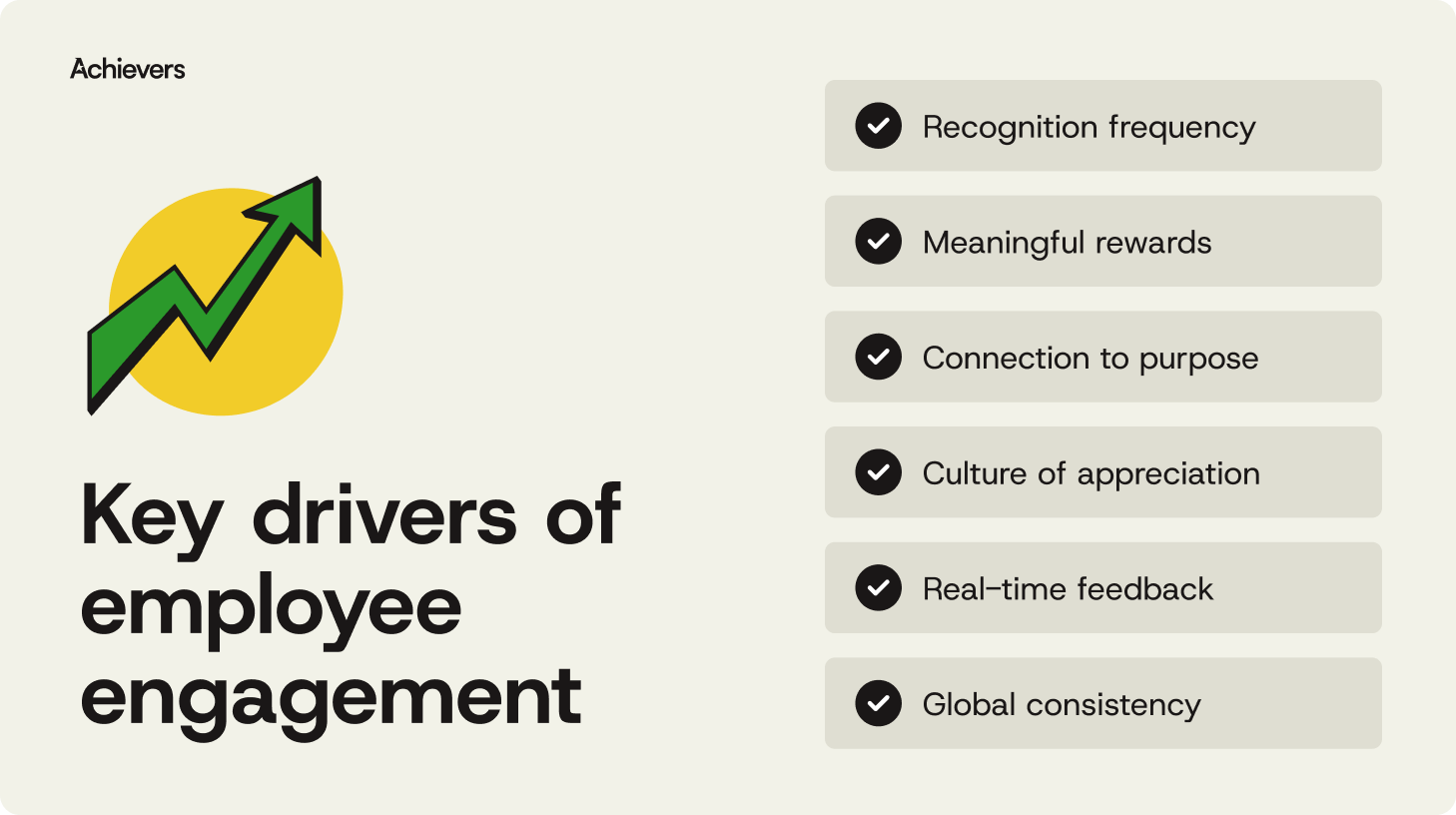Table of contents
Create a culture that means business™
Schedule a demo with an Achievers solution expert today.
Employee engagement isn’t some mysterious workplace alchemy — it’s the result of intentional, human-centric actions that help people feel seen, heard, and appreciated. When employees feel genuinely connected to their work, their colleagues, and their purpose, good things happen — like productivity, loyalty, and maybe even fewer “urgent” calendar invites.
In this post, we’re unpacking 12 proven drivers of engagement and showing how Achievers helps HR leaders turn each one into something more than just a checkbox — real, measurable business impact. Because at the end of the day, shaping your workforce starts with understanding what drives it.
12 powerful drivers of employee engagement (and how Achievers helps you deliver on all of them)
Engagement isn’t one-size-fits-all — it’s a mix of mindset, motivation, and meaningful moments. The good news? You don’t need a crystal ball or a trust fall to figure out what matters most. These 12 drivers are backed by research, proven in practice, and ready to be brought to life with the right tools.
And by “right tools,” we mean Achievers. We make it easier to turn each of these drivers into daily habits, not annual goals — no spreadsheets required.

1. Recognition frequency
Recognition works best when it’s frequent and timely — not saved for the annual review or a once-a-year gala. A simple, “Hey, I saw what you did there,” right when it happens is enough to reinforce great behavior and make someone feel genuinely valued. In other words, the sooner the better (and the more often, the better still).
Achievers edge
Achievers users recognize twice as often as users on other platforms. Why? Because recognition is built right into the daily flow of work — no detours, no friction, no forgetting. With a few clicks, kudos is delivered. It’s recognition without the rigmarole. Backed by the data from Achievers Workforce Institute (AWI), of course.
2. Meaningful rewards
Rewards shouldn’t feel like a generic afterthought (looking at you, dusty trophy). When recognition is paired with a reward that actually means something to the recipient — whether that’s a weekend getaway, a favorite brand, or a charity donation — it turns a good moment into a lasting one. The key? Personalization. Because motivation isn’t one-size-fits-all.
Achievers edge
With over 3 million global reward options from 2,500+ vendors (yes, really), Achievers delivers meaningful rewards that resonate. From tailored experiences to local favorites, there’s something for everyone — and the best part? It scales with you. That means more smiles per dollar, everywhere your workforce works.
3. Connection to purpose
People want to know their work matters — not just to their manager, but to the company’s mission. When employees see how their efforts connect to company goals, they feel more invested, more engaged, and more likely to go the extra mile. Purpose isn’t a perk — it’s a performance driver.
Achievers edge
Achievers helps organizations turn company values from wall art into real action. Every recognition can be tied to a core value, reinforcing purpose in a way that’s consistent, visible, and motivating. It’s culture-building in real time — and it reminds people that what they do matters. Because it does.
4. A culture of appreciation
Appreciation shouldn’t be a once-a-quarter checkbox — it should be part of how your organization operates every day. When gratitude is baked into the company culture, people notice. Engagement improves, turnover drops, and “thank you” becomes business as usual. It’s the kind of workplace people don’t just work at — they stay at.
Achievers edge
Achievers makes it easy to build recognition into the DNA of your company. With the most robust set of pre-built campaigns in the industry, leaders at every level can kickstart appreciation efforts without reinventing the wheel. It’s recognition with structure — not stiff, just smart.
5. Real-time feedback
Delayed feedback is like a GPS that only updates after you’ve missed the exit. Employees thrive when they get input in the moment — it builds confidence, reinforces the right behaviors, and creates space to grow without the guesswork. Ongoing feedback turns work into a learning loop, not a pop quiz.
Achievers edge
With real-time recognition built into everyday tools, Achievers makes feedback immediate and actionable. Employees know where they stand, what’s working, and what to keep doing — right when it counts. It’s like coaching on autopilot, minus the whistle.
6. Global consistency
A strong culture shouldn’t stop at the border. When recognition and engagement feel consistent — whether you’re in Toronto, Tokyo, or Toulouse — employees feel part of something bigger. Alignment across regions fuels collaboration, clarity, and a sense of belonging that spans continents, not just cubicles.
Achievers edge
Achievers is built for global scale, with support in 200+ languages and expertise in local fulfillment and tax compliance. That means your people get a consistent experience, no matter where they log in. It’s one platform, one culture — globally fluent and regionally smart.
7. Employee voice
Employees don’t just want a seat at the table — they want to know their input actually matters. When people feel heard, they engage more deeply, contribute more freely, and stick around longer. Listening isn’t just a nice-to-have. It’s a competitive advantage disguised as empathy.
Achievers edge
Achievers goes beyond surveys. It captures real-time employee feedback, translates it into actionable insights, and closes the loop with visible outcomes. It’s not just about hearing what people say — it’s about proving you’re listening. Because when you act on feedback, trust follows.
8. Aligned behaviors and values
Company values shouldn’t be collecting dust on a poster in the breakroom. When employees understand — and live — those values in their daily work, engagement soars and so does performance. It’s not magic. It’s alignment. And it’s how good intentions turn into great outcomes.
Achievers edge
Achievers helps bring your values to life with targeted recognition campaigns that reinforce the behaviors you want to see more of. It’s recognition with purpose — shaping how people work and aligning teams around what matters most. Values, meet velocity.
9. Ease of use and integration
Even the best tools won’t drive engagement if they’re clunky or live outside the flow of work. To stick, recognition needs to be frictionless — easy to access, simple to use, and naturally part of the day-to-day. Because if it feels like “extra work,” it won’t work.
Achievers edge
Achievers fits right into the tools your teams already use — from Slack to Teams to Outlook — making recognition feel like second nature. No new tabs, no steep learning curve, just seamless integration that boosts adoption and builds a habit of appreciation. Easy in, big impact out.
10. Employee-driven experiences
Culture isn’t a top-down directive — it’s built from the ground up. When employees are empowered to shape their experience, they become more connected, motivated, and engaged. Participation turns passive observers into active culture creators. That’s when the magic (okay, psychology and strategy) happens.
Achievers edge
Achievers puts recognition in everyone’s hands. With an intuitive, human-centric platform, employees at every level — whether they’re at a desk or on the floor — can easily recognize and be recognized. It’s engagement that’s democratized, decentralized, and deeply effective. Culture built by everyone, for everyone.
11. Support and enablement
Even the best engagement programs lose steam without ongoing support. HR teams and people leaders need more than software — they need a co-pilot. From launching campaigns to keeping momentum, having expert guidance ensures your program doesn’t just start strong, it stays strong.
Achievers edge
With Achievers, you’re never flying solo. You get a dedicated success manager, 24/7 live support (yes, really), and expert help crafting recognition campaigns that stick. It’s more than a platform — it’s a partnership built to grow with you. Because engagement isn’t a one-and-done; it’s a long game, and we’re in it with you.
12. Data-driven decisions
Gut feelings are great — but engagement strategies work best when backed by data. With real-time insights into what’s working (and what’s not), organizations can make smarter decisions, faster. It’s like having a cultural GPS: no more guesswork, just confident, course-corrected action.
Achievers edge
Achievers puts powerful insights at your fingertips. With flexible reporting and support from AWI data, you get research-backed guidance and real-time data to shape your culture as it evolves. It’s not just about knowing what’s happening — it’s about knowing what to do next.
Build a culture they won’t want to leave
When your engagement strategy supports all 12 of these drivers, you create more than a workplace — you build a culture where people feel seen, heard, and appreciated (and not just during performance review season). The best part? You don’t have to figure it out solo.
Achievers gives you the tools, insights, and support to turn good intentions into measurable results. Because shaping your workforce shouldn’t feel like guesswork — or a one-person job.



